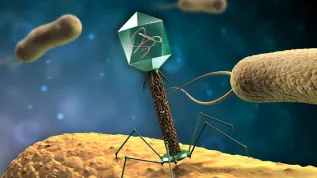
Professor Jacek Szepietowski from Wrocław University of Science and Technology, and an international team of researchers, have developed a new model of treatment for a burdensome skin disease - HS (hidradenitis suppurativa). He published the results of his work in the prestigious journal The Lancet.
According to specialists, this may change the approach to the treatment of patients with this quite common and very burdensome disease.
Hidradenitis suppurativa (HS), also known as acne inversa, is a chronic, inflammatory skin disease that affects about 1% of the population worldwide. It is characterized by painful, deep lumps, abscesses and fistulas in places such as the armpits, groin, genital area and under the breasts. The disease not only significantly reduces the quality of life of patients, but also - through the inflammation it is associated with - negatively affects many organs of the body, which can lead to serious systemic complications, e.g. inflammatory diseases of the joints and intestines, mood disorders, depression and metabolic disorders, including diabetes. All this consequently increases the risk of cardiovascular diseases.
Professor Jacek Szepietowski, dermatologist and venereologist from the Faculty of Medicine of the Wrocław University of Science and Technology and president of the Polish Dermatological Society, emphasises that HS affects one in a hundred people, so as many as 350 thousand people in Poland may suffer from it. Despite this, knowledge about it is still quite limited, both among doctors and the public.
'HS causes enormous psychosocial suffering and leads to millions in losses related to loss of professional activity', emphasises the specialist, quoted in the university's press release.
In recent years, largely thanks to Szepietowski's earlier work, there has been progress in research on the pathogenesis of HS, which has resulted in new treatment methods, based mainly on the neutralization of cytokines. Cytokines are molecules involved in initiating inflammation, maintaining it, and even maintaining pathological pain.
Now, an international team of researchers, coordinated by the Polish expert, has developed a completely new model of therapy, taking into account all the important factors that affect its course, i.e. the phases of disease development (which the authors of the publication were the first in the world to distinguish), and comorbidities. The scientists call their approach personalized and interdisciplinary.
They remind in the publication in „The Lancet” that hidradenitis suppurativa usually appears in the second or third decade of life (mainly in the age group of 18-35 years) and generally affects women much more often than men, although in Central Europe this ratio is 1.5:1, and in East Asia men get sick just as often, if not more often. In many cases, the first symptoms are misdiagnosed as boils, skin infections or sexually transmitted diseases, which leads to an average diagnosis delay of 10 years.
Lack of prompt diagnosis results in most patients developing serious skin lesions, including fistulas and scars, which can even lead to impaired motor functions and limitation of professional activity. Numerous comorbidities accompanying HS also cause a significant deterioration in the quality of life and general health of patients.
Szepietowski's team distinguished three phases of the disease: inflammatory, destructive and burnout.
The scientist explains that in the first phase, painful nodules and abscesses appear on the body, but the skin is not yet permanently damaged. In the second phase, fistulas and scars develop, leading to permanent skin damage. In the burnout phase, the inflammation subsides, but the remnants in the form of fibrosis and scars can cause further complications.
The therapeutic approach developed by the researchers includes pharmacotherapy, surgical methods, and lifestyle modifications. Its early implementation is crucial for stopping the progression of the disease and avoiding serious skin damage.
Until recently, the treatment of HS was mainly limited to the use of antibiotics, which did not always bring the expected results. Currently, patients are prescribed biological drugs that neutralize key inflammatory cytokines such as TNF-alpha and IL-17. These are: adalimumab (anti-TNF drug), approved in 2015, which effectively reduces the number of inflammations and fistulas, secukinumab (anti-IL-17A drug), approved in 2023, which reduces inflammation and prevents the formation of new skin lesions, and bimekizumab (anti-IL-17A and IL-17F drug), approved in 2024, which has broad anti-inflammatory effect.
There are also other promising therapies in clinical trials, including drugs that block IL-1, IL-36, and JAK kinase inhibitors.
In the case of advanced HS, scientists have also proposed surgical methods. Their scope can vary: from the removal of individual lesions to extensive procedures to cut out fistulas and scars. According to the authors of the publication, the key is the combination of surgery with biological drugs, which allows to reduce the risk of relapses and improve the quality of life of patients.
The third step in the model proposed by the team is lifestyle changes. Reducing body weight, quitting smoking and avoiding mechanical irritation of the skin can significantly reduce the frequency of exacerbations. Psychological help for patients is also important, as it teaches them how to cope with stress and stigmatisation, which often accompany this condition.
(...) to stop the progression of cutaneous inflammation, eliminate or minimise cutaneous symptoms, and prevent or, if already present, treat the concomitant diseases (...) early diagnosis and timely initiation of effective inflammation-reducing therapy are crucial, Professor Jacek Szepietowski concludes.
In his opinion, one of the biggest problems in the care of patients with HS is the delayed diagnosis. Within 10 years of the first symptoms appearing, the average patient visits at least three different doctors and often receives an incorrect diagnosis. Meanwhile, the earlier the diagnosis is made, the greater the chance of effective treatment and avoiding complications.
'We hope that our publication will shorten the time needed to make the correct diagnosis, increase awareness of the systemic nature of the disease and the serious health consequences of HS, and provide the necessary resources for further translational research and interdisciplinary patient care', Szepietowski says.
The research team also included another Polish scientist, Professor Łukasz Matusiak from the Wrocław University of Science and Technology. Other experts represented the Charité Medical University in Berlin, Northwell Health in New York, Mayo Clinic in Rochester, the Faculty of Medicine in Santiago de Chile and the Irish Munster.
Professors Szepietowski and Matusiak have been conducting research on the pathogenesis and treatment of HS for over 20 years. They are the authors of numerous scientific papers on this topic. They were the first in the world to demonstrate, among other things, elevated levels of TNF-alpha and IL-17 in patients with HS, which paved the way for the development of effective biological therapies. They have also documented the effectiveness of acitretin in the treatment of this disease, especially its follicular type.
The Polish researchers also take an active part in developing European guidelines for the diagnosis and treatment of hidradenitis suppurativa, and conduct international courses for doctors.
Katarzyna Czechowicz (PAP)
PAP - Science in Poland
kap/ bar/













